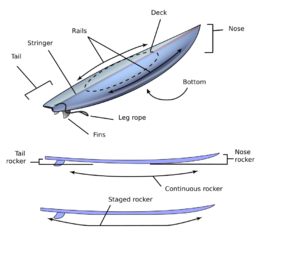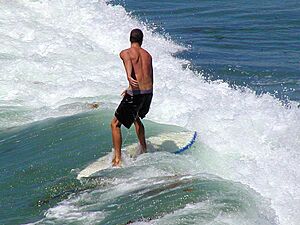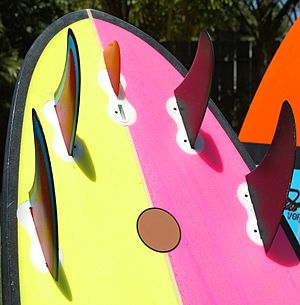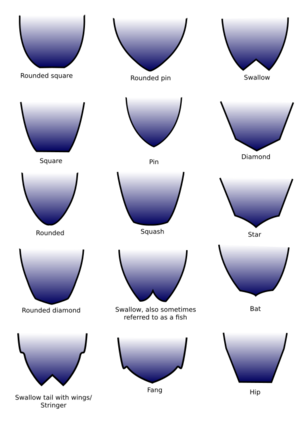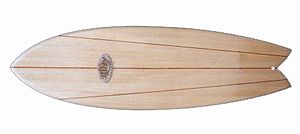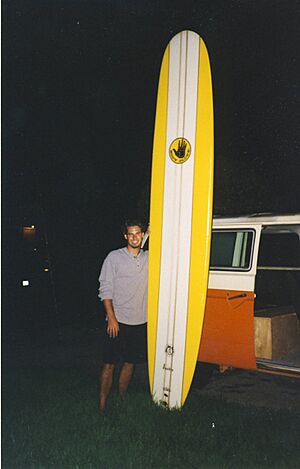Surfboard facts for kids
A surfboard is a special board used for surfing. It's light enough to float, but strong enough for a person to stand on while riding an ocean wave. Surfboards were first made in ancient Hawaii. People there called them papa he'e nalu. They were usually made from local wood, like koa trees, and could be very long, sometimes over 460 cm (15 ft)! They were also super heavy.
Over the years, surfboards got much better. One big change was adding fins (also called skegs) to the bottom rear. These fins help the board go straight. Materials and shapes also improved a lot.
Today, most surfboards are made from polyurethane or polystyrene foam. This foam is covered with layers of fiberglass cloth and polyester or epoxy resin. This makes surfboards light, strong, floaty, and easy to steer. A man named Reginald Sainsbury invented the Polystyrene surfboard in the early 1960s. Newer boards even use super strong materials like carbon fiber and kevlar. Some are even made from eco-friendly materials! About 400,000 surfboards are made every year.
Contents
Choosing Your Surfboard
Picking the right surfboard can be tricky. It depends on a few things:
- Your skill level and how you like to surf.
- The type of waves you expect to ride.
- Your height and weight.
For a long time, people mainly chose boards based on their height. Taller surfers usually got longer boards. Now, how much a surfer weighs is also important. Heavier surfers often need boards with more volume (which means they float better).
Parts of a Surfboard
The Bottom
The bottom of the surfboard is the part that touches the water. It's usually curved inwards (concave) but can sometimes be curved outwards (convex). Some boards also have special channels on the bottom to help water flow better.
Concave Bottoms
Many modern surfboards have curved shapes on their bottom, called concaves. These curves help guide the water through the fins. This can make the board faster and easier to turn. Surfboard makers often try different concave shapes to see how they affect the board's ride.
Convex Bottoms
Some older surfboards, and new boards inspired by them, have a curved-out (convex) bottom. These boards push more water and sit lower in the wave.
The Deck
The deck is the top surface of the board where you stand. Sometimes, the deck also has special shapes or channels. Surfwax is put on the deck to help your feet grip the board. Wax comes in different types for different water temperatures.
Fins
A surfboard fin is like a small rudder on the back of the board. It stops the board from sliding sideways. Long ago, surfers used their toes in the water to steer!
The first person to add a fin to a surfboard was an American surfer named Tom Blake in 1935. He used a part from an old speedboat. This idea changed surfing forever! It helped surfers steer and balance much better.
In the 1960s, George Greenough designed the modern fin shape. For a while, most boards had just one fin. Then, in the late 1970s, Australian surfer Mark Richards made two-fin boards popular. In 1980, Simon Anderson came up with the "thruster" design, which uses three fins of equal size. This design is still the most popular today!
In the 1990s, removable fins became common. This means surfers can easily change their fins to make the board ride differently. There are many types of fins now, like those with special curves or even tiny wings!
Thrusters and Tri-fins
The "thruster" or "tri-fin" design tries to combine the smooth ride of a longboard with the quick moves of a shortboard. The three fins help the board turn better, especially when riding down the wave.
Quad Fins
A "quad" board has four fins, usually in two pairs. These boards are very fast when going straight, but they might lose some speed when turning.
Nubster Fin
The Nubster fin was created by pro surfer Sean Mattison. It's a small, fifth fin used at the back of the board for extra stability. Pro surfer Kelly Slater used it to win contests in 2011.
Leash
A surfboard leash, or leg rope, is a cord that connects the surfboard to the surfer. It stops the board from being washed away by waves and keeps it from hitting other surfers or swimmers. Modern leashes are made of urethane. One end straps to the surfer's ankle, and the other straps to the tail of the surfboard.
Before leashes came out in 1971, surfers had to swim to get their boards back after falling. This was annoying and could be dangerous. Pat O'Neill from Santa Cruz helped make the leash popular. His first designs used surgical tubing. At a contest in 1971, Pat was disqualified for wearing his leash! But soon, everyone started using them.
Sadly, Jack O'Neill (Pat's father) lost an eye in a leash accident. The early surgical tubing could stretch too much, making the board snap back at the surfer. Later leashes were made with less stretchy materials, like urethane, to make them safer.
Even today, some longboarders don't like leashes because they feel it gets in the way of walking on the board. But in crowded places with big waves, leashes are important for everyone's safety.
Leash Cup
This is a small hole near the tail of the board. It has a metal bar where you attach the leash cord.
Nose
The nose is the front tip of the board. It can be pointy or rounded. It can also curve up a lot (steep "rocker") or just a little.
Tail
The tail is the back end of the board. Its shape changes how the board moves. Common tail shapes include square, pin, squash, and swallow. A pin tail helps the board go faster, while a hip tail helps with balance.
Traction Pad
Traction pads (also called deck grips or tailpads) are pieces of foam stuck to the top of the surfboard, usually near the tail. They help surfers get a better grip and control the board for cool tricks. Popular brands include Dakine and Pro-Lite.
Rails
The rails are the edges of the board. "Soft" rails are rounded, while "hard" rails are more squared off. Rails affect how the board floats and how easily it can be tilted into a turn. When you ride a wave, one rail is usually in the water, and the other is in the air. Turns involve moving from one rail to the tail and then to the other rail.
Rocker
Rocker is the curve of the board from nose to tail. A "heavy" rocker means a steep curve, while a "relaxed" rocker means a flatter curve.
The nose rocker is the curve at the front, and the tail rocker is the curve at the back. A bigger nose rocker helps stop the board from diving under the water. A bigger tail rocker makes the board easier to turn and gives it more lift when moving fast. Boards with more relaxed rockers are better on flatter water, while heavy rockers help with tighter turns.
Stringer
The stringer is a thin, stiff strip, usually made of wood or carbon fiber, that runs down the middle of the board from nose to tail. It makes the board stronger and less flexible. Some boards have more than one stringer.
How Surfboards Are Made
Surfboards are designed to float well and have a strong top surface. They are usually made from foam with a hard outer skin.
Sometimes, the outer skin (like fiberglass) can separate from the foam inside. This is called delamination. It often happens because of too much heat.
Modern surfboards are usually made with one of these foam types:
- Polyurethane (PU foam) with polyester resin: This has been used since the 1950s and is the oldest modern way to make boards. PU foam is easy to shape by hand, which makes building boards faster. PU boards are often cheaper. However, the material can be toxic, isn't easily recycled, and can bend more during use. PU foam can also soak up water and turn yellow over time. Even with these drawbacks, PU is still the most common material for surfboards today.
- Polystyrene (PS foam) with epoxy resin: PS foam is lighter than PU, but not as strong on its own. So, it's covered with epoxy to make it stronger. There are two main types of PS foam: EPS and XPS. You can't use polyester resin with PS foam because it will melt the foam! PS foam boards are better for the environment, last longer, and can be recycled. But they take much longer to shape by hand. Many pro surfers still prefer PU boards.
- Expanded polystyrene (EPS) is the lightest foam used for surfboards. It's hard to shape by hand, so EPS boards are often made by machines. EPS foam can soak up water more easily because it has small air gaps between its cells.
- Extruded polystyrene (XPS) is a bit heavier than EPS or PU. It's very good at resisting water because it has a solid, closed-cell structure.
Fiberglass is the most common material for the outer skin, no matter what foam is used. Other skin materials include bamboo, carbon fiber, and kevlar.
Polyurethane (PU) Boards
These boards are made from polyurethane foam. They often have one or more stringers for strength. The foam is shaped into a "blank," then skilled shapers cut and sand it into the final surfboard shape. Finally, layers of fiberglass cloth and resin are added. This is also when fins and leash plugs are put in. Machines are now often used to shape boards, making them faster to produce.
Balsa Boards
Balsa wood was used for surfboards in Hawaii long ago. It's light and strong, making it great for boards. After World War II, when fiberglass skins were invented, shapers could finally use this delicate wood to make entire surfboards. Balsa wood boards are lighter, float better, and are easier to handle.
Hollow Wooden Boards
Hollow wooden surfboards are made entirely of wood and epoxy (or oil). They don't have foam inside. These boards are a return to older ways of building, and they are more eco-friendly than foam boards. They use fast-growing woods like paulownia and cedar. Hollow wooden boards are usually heavier than foam boards, but they are beautiful and good for the environment.
CUSH - Skinned Surfboards
One of the newest ideas in surfboard technology is boards wrapped in a soft, stretchy skin that doesn't soak up water. These "Cush" (cushion) boards have an epoxy surfboard inside, with an EPS foam core. The soft skin is stretched over the board. This skin helps absorb impacts, provides grip, and protects the board.
Types of Surfboards
Shortboard
Since the late 1960s, shortboards have been very popular. They are usually between 180 to 210 cm (6 to 7 ft) long, with a pointy nose and a rounded or square tail. Most have three fins. Shortboards are super quick to turn, but because they are smaller and don't float as much, they are harder to catch waves with. They work best on steeper, bigger waves.
A Bonzer is a type of surfboard designed by the Campbell Brothers. It can have three or five fins and special deep channels on the bottom that help guide the water.
Hybrid Boards
Modern hybrid boards are usually 180 to 260 cm (6 to 8.5 ft) long with a more rounded shape. They are often used in smaller waves and are more about having fun than doing fancy tricks. They can be easier for beginners to ride.
Fish Boards
Fish boards are usually short and stubby, under 180 cm (6 ft) long. They were developed in 1967. They usually have two fins and a "swallow" tail shape. Fish boards are great for smaller waves and became very popular again in the early 2000s.
Funboards
Funboards mix ideas from both shortboards and longboards. They are usually medium-sized, around 210 to 240 cm (7 to 8 ft) long. Funboards are easier to catch waves with than shortboards, but they are still easier to turn than longboards. This makes them popular for beginners or those moving from longboards to shortboards.
Gun Boards
"Guns" are big wave boards, usually 210 to 370 cm (7 to 12 ft) long. They have a thin, pointy shape, like a needle. Guns are used at famous big wave spots like Waimea Bay and Jaws in Hawaii.
Longboard
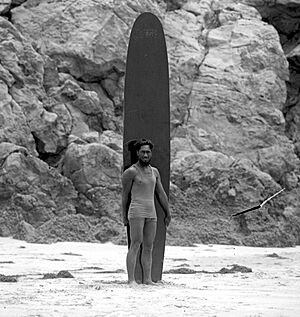
Longboards are usually single-finned boards with a large, rounded nose. They are typically 270 to 370 cm (9 to 12 ft) long. Longboards float very well and have a big surface area, which helps surfers catch waves that are too small for shortboards. They are great for beginners because they are stable and easy to catch waves with. A cool trick on a longboard is to "hang ten," where the surfer walks to the very tip of the board and hangs all ten toes over the edge!
Classic Longboards
Longboards are the original surfboards! The ancient Hawaiians used solid wooden boards that were sometimes 270 to 910 cm (9 to 30 ft) long and weighed up to 70 kg. Both men and women surfed, but the longest boards (called Olo) were only for royalty. For a while, surfing almost disappeared because some missionaries didn't like it.
In the early 1900s, surfing started to grow again. Duke Kahanamoku, a Hawaiian Olympic swimmer, helped bring surfing to the United States and Australia in the early 1900s. He's known as the "Father of Modern Surfing." In the 1950s, longboards became very popular. They started being made from lighter balsa wood instead of solid wood.
In the 1960s, the "shortboard revolution" happened. Shortboards, around 200 cm (6 ft 6 in) long, allowed surfers to make much tighter turns and go faster. This made longboards almost disappear. But in the early 1990s, longboards came back! Surfers rediscovered how fun it was to ride them and do classic moves that shortboards can't do. Today, many surfers enjoy riding both longboards and shortboards, depending on the waves.
Modern Longboards
Today's longboards are much lighter than old ones. They are usually 240 to 300 cm (8 to 10 ft) long. The classic single-fin longboard still has its traditional design, but new technology has led to different types of longboards.
The 2+1 Longboard
This is a very flexible longboard. It has a large center fin and two smaller side fins. It combines the stability of a classic longboard with the turning power of a three-fin board.
Mini Tanker
The mini tanker is like a shorter longboard. It has the same design ideas as a longboard but is easier to move around because it's shorter.
The Malibu
Named after Malibu, California, this longboard is a bit narrower than others. It's great for turning and has been loved by experienced surfers. You can do classic tricks on a Malibu, like "Hang Fives" and "Hang Tens" (where you hang your toes over the nose of the board).
Olo Boards
These were very long wooden boards, sometimes over 730 cm (24 ft) and weighing up to 90 kg! Only Hawaiian royalty were allowed to use them.
Alaia Boards
Alaia boards are traditional finless wooden surfboards, also used by ancient Hawaiians. They can be very thin, sometimes only 2 cm (3⁄4 in) thick, and as short as 180 cm (6 ft). They are known for being quite difficult to ride!
Tandem Boards
A tandem board is an extra-large longboard big enough for two people to surf together!
Images for kids
-
Surfer in California
See also
 In Spanish: Tabla (surf) para niños
In Spanish: Tabla (surf) para niños


